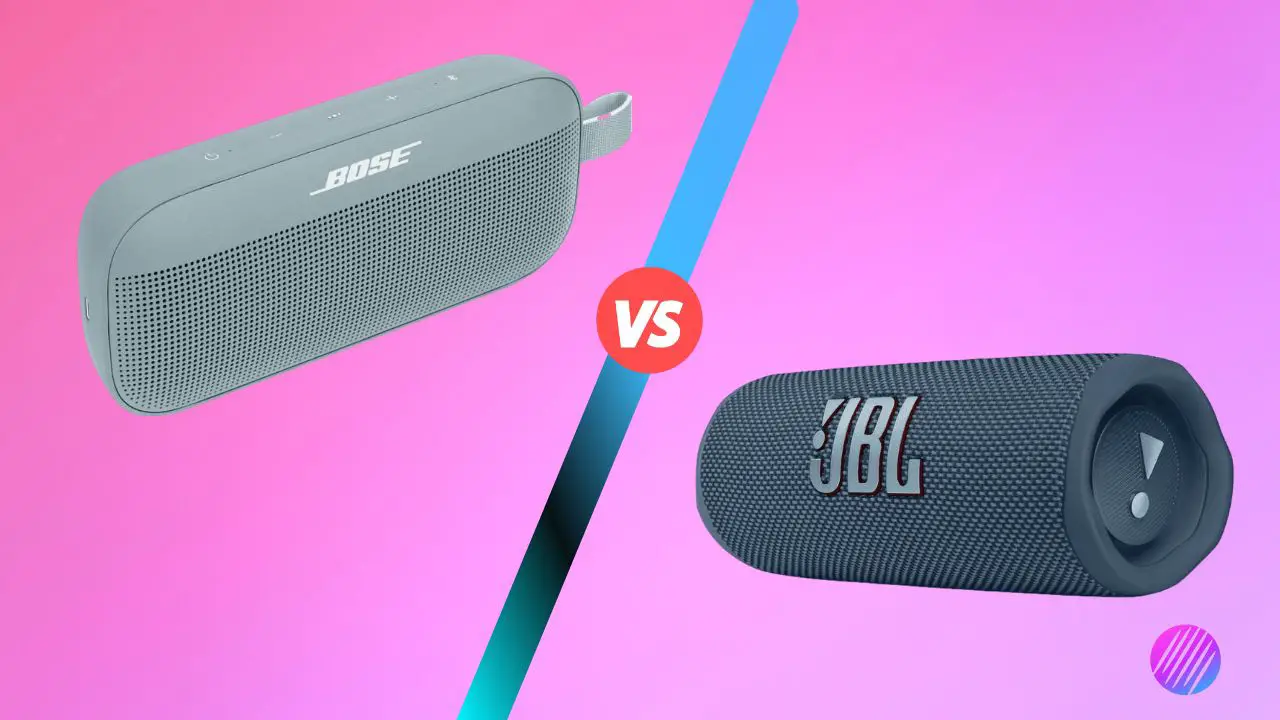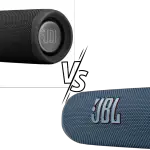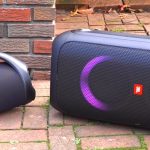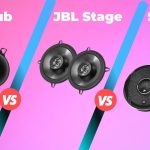With the ongoing evolution in home theater equipment, audio manufacturers are trying to up their game of audio product quality to appeal to more audiences. Bose Soundlink Flex and JBL Flip 6 are the two latest Bluetooth speakers that stand as audio competitors, leaving the audio enthusiasts with which one is a better option.
To determine which stands out, look at these speakers’ features, sound quality, design language, and durability.
Quick Comparison: Bose Soundlink Flex Vs. JBL Flip 6
| Feature | Bose Soundlink Flex | JBL Flip 6 |
|---|---|---|
| Price | 149 | 129 |
| Weight | 0.6 kg | 0.5 kg |
| Battery Life | 12 hours | 12 hours |
| Charging Time | 4 hours | 2.5 hours |
| Bluetooth Version | 4.2 | 5.1 |
| Dust Resistance | Yes(IP67) | Yes(IP67) |
| Water Resistance | Yes(IP67) | Yes(IP67) |
| Frequency response | 60Hz-15.6KHz | 65Hz-20KHz |
| Voice Assistants | Yes | No |
| WiFi | No | No |
| Input | USB-C | USB-C |
| Voice Prompts | Yes | No |
| Microphone | Yes | No |
| Companion App | Bose Connect App | JBL Portable App |
| Equalizer | No | Yes(Via App) |
| Supports Airplay | No | Yes |
| Partyboost | No | Yes |
Which One’s Better: Bose Soundlink Flex Vs. JBL Flip 6.
Design and Durability:
The design of the Bluetooth speaker is the first essential to consider to decide which one stands out. Bose and JBL are renowned for manufacturing durable, rugged speakers to sustain rough handling and have a smart design for better portability. If you’re interested in how Bose Soundlink Flex compares to another JBL model, check out our JBL Charge 5 vs. Bose Soundlink Flex comparison.
JBL Flip comes in 9 different colors to appeal to more audiences and target each age group, and it has a cylindrical design with only 0.5 kg weight, making it easier to carry around. This Bluetooth speaker also has a thread that helps users carry it anywhere they want.
There is a mesh fabric covering the speaker from everywhere, and there are two rubber end caps on each side of the speaker to protect the speaker against major or minor drops. I tested out the sturdiness of the JBL Flip 6 through drop tests, where it was dropped from a height of 4-5 feet on three different floor types, i.e., concrete, grass, and sand, to see if it could sustain without damage. Surprisingly, only the rubberized sides took the hit, while the speaker and the sound drivers remained unharmed, delivering quality audio.
Furthermore, the speaker has an IP67 rating for dust and water protection. I tested it by submerging the speaker in water for about 30 minutes. The audio inside the water sounded a bit muffled; however, the sound drivers remained unharmed.
In comparison, the Bose Soundlink has a limited color range of only four neutral colors, giving them a more decent and timeless look. The speaker has a rectangular tablet-like design, with a tough metal grille at the front for protecting the sound drivers and a hard silicone covering at the back and sides of the speaker.
In a similar drop test as the JBL Flip 6, the Bose Soundlink Flex remained intact and unharmed when dropped from a height of 4-5 feet, and there were minimum to no marks on the silicone body. Furthermore, the silicone body could be easily wiped to look like the new.
In addition, the speaker also has a fabric handle, which you can attach to any carabiner for carrying it easily on outdoor trips. Bose Soundlink Flex is highly portable because of its lightweight, i.e., only 0.6 kg. Finally, just like JBL, this speaker also has an IP67 rating, making it dust and water-resistant.
So, regarding durability, according to my testing and experience, both the speakers are at the same pace.
Features:
Let’s discuss the features of each of these speakers one by one to distinguish which one is better.
First, both speakers have an IP67 rating against dust and water, which means they are submersible in water for upto 30 minutes without any damage. Both have a Type-C charging port and a companion app for wireless phone control. However, JBL Flip 6’s companion app provides an Equalizer function to adjust the audio’s bass, mid, and treble as desired; however, Bose Soundlink Flex doesn’t have such a privilege.
In addition, both speakers do not support Wi-Fi connectivity; however, JBL supports Airplay, which allows it to connect to different iOS devices and share music easily. Furthermore, it also has a partyboost feature, which Bose Soundlink Flex doesn’t have; this feature allows JBL Flip 6 to connect to multiple partyboost compatible speakers for simultaneous audio playback.
On the other hand, Bose Soundlink Flex has a built-in microphone, allowing Voice Assistants, such as Google Assistant and Siri, for hands-free control.
Audio Quality:
Now, let’s talk about both speakers’ audio quality. JBL Flip 6 has a more bass-oriented sound signature with a power output of 20 watts and a frequency response of 65 Hz to 20 kHz. If you’re curious about how the Flip 6 compares to its predecessor, our JBL Flip 6 vs. Flip 5 comparison provides more insights. This speaker covers the most frequency range audio. With the benefit of having an Equalizer in the companion app, the user can adjust the audio level as desired. However, this speaker may not do well for heavy, punchy bass audios.
In a sound test, I observed that the JBL Flip 6 has a decent sound profile, clear mids and dialogue delivery, and a deep bass.
On the other hand, Bose has an overall balanced sound signature with a frequency response of 60Hz-20KHz. It covers almost all frequency audios and has great clarity of dialogues, which means you can enjoy the Audiobooks and podcasts easily. However, this speaker might deliver a different bass than the bigger and more powerful speakers for heavy bass-audio content like hip-hop and metal.
In the sound test, I observed that Bose Soundlink Flex has a clear punch of bass, which is quite impressive for its size and without any equalizer adjustments.
Furthermore, I also tested out the iQ positioning feature of the speaker in the sound test, which allowed the speaker to adjust the audio according to the speaker’s position. So, all in all, despite not having an equalizer, the Bose Soundlink Flex speaker still has a better audio response than the JBL Flip 6.
So, in my opinion, looking at the overall performance and sound test result, the JBL Flip 6 does a better job than the Bose Soundlink Flex.
Bluetooth:
JBL Flip 6 and Bose Soundlink Flex are Bluetooth speakers and connect wirelessly with the audio source. However, the version of Bluetooth that they use is different. JBL Flip 6 uses an advanced version of Bluetooth, which is 5.1. Bluetooth 5.1 has a better connectivity range, lag-free audio transmission, and faster connectivity; however, Bose Soundlink Flex features Bluetooth 4.2, which is also great but is a few paces behind its competitor, JBL Flip 6.
Battery Life:
Both Bluetooth speakers have the same battery life of 12 hours, making them great for longer hours. The charging time for the JBL Flip 6 is only 2.5, less than the Bose Soundlink Flex, which has a charging time of 5 hours.
In a sound test, I observed that the JBL Flip 6 battery lasted 9 hours when the music was played moderately. Furthermore, the battery drained faster when the volume was raised to maximum and heavy metal audio was played on the speaker.
In a similar sound test, the Bose Soundlink Flex battery lasted a bit longer and up to 10-11 hours. So, in my opinion, Bose Soundlink Flex has a better take in terms of battery life.
Price:
The speaker’s price also makes a ton of difference when purchasing one. It all comes down to the budget you have allotted for the purchase, and in this case, Bose Soundlink Flex is slightly expensive, with a price of $149, as compared to the JBL Flip 6, which has a price of $129.
Usage: Bose Soundlink Flex Vs. JBL Flip 6
Beaches and Bonfires
According to my test and experience, both JBL Flip 6 and Bose Soundlink Flex fit perfectly in these two activities because of their IP67 rating, making them highly dust and water-resistant. However, JBL Flip 6 hours has the advantage of the Partyboost feature. It allowed us to connect more compatible speakers to extend the music range by a daisy chain of connected speakers. If you’re on a budget but still looking for quality, you might also be interested in our list of the best budget Bluetooth speakers.
Furthermore, the Bose Soundlink Flex doesn’t perform well with many ambient noises in our tests. It’s harder for Bose Soundlink Flex to entertain anyone more than a foot away. Whereas JBL Flip 6 had a powerful output for outdoor use.
Hiking
The IP67 rating and 12-hour battery life make both speakers ideal for hiking. However, the Bose Soundlink Flex has a stronger handle, making the speaker grip better with the bag without dropping or breaking.
In addition, these speakers also have a built-in microphone, which supports the voice assistants for hand-free controls. The durability of this speaker, without any question, is just at the high end, which protects the speaker from major or minor drops up to 4-5 feet. However, according to my observation, with many ambient sounds, the Bose Soundlink Flex speaker could not deliver great audio any further than one foot.
Larger Gatherings
My fair testing with both speakers showed that JBL Flip 6 is a better speaker option for larger gatherings and parties. Its Partyboost feature impressed the audience with synchronized audio playback on a daisy chain of Partyboost-compatible speakers.
Furthermore, the audio of JBL Flip 6 is perfect for open areas.
Final Words
Despite all the comparisons, the choice of a speaker depends entirely on your audio preferences, usage, budget, and the features you’re looking for in a speaker.
In my opinion and experience, the JBL Flip 6 is a better option for the speaker because of its durability, Ip67 rating, Bluetooth 5.1 for better range, faster connectivity, and lag-free audio transmission. Furthermore, its powerful audio and frequency response to cover most audios and bass-oriented audio signature make it greater for outdoor use. It also features a partyboost feature for connecting the speaker with other partyboost compatible speakers for playing audio in multiple rooms or larger gatherings.
In addition, this speaker also has a long battery life of 12 hours, with a charge time of only 2.5 hours. It has a companion app for remote speaker control and an Equalizer function to adjust the audio content’s bass, mid, and treble, as desired.
However, you can choose Bose Soundlink Flex without hesitation for a more neutral audio signature. With its iQ positioning technology, this speaker automatically adjusts audio according to the speaker’s position. Furthermore, it has a built-in microphone for Voice Assistant support, a neutral and well-balanced audio signature to target the needs of most users, and a 12-hour battery life. So, if you want these additional features and a balanced sound signature, Bose Soundlink Flex is worth spending the extra dime.

I’m Shaun Conroy, an audiophile & founder of HiFi Audios. Holding a Bachelor’s in Sound Engineering, I bring deep expertise in audio devices and offer insights & recommendations to fellow enthusiasts.





